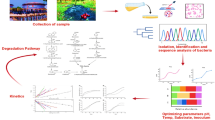Abstract
The soil nitrifying bacterium Nitrosomonas europaea has shown the ability to transform cometabolically naphthalene as well as other 2- and 3-ringed polycyclic aromatic hydrocarbons (PAHs) to more oxidized products. All of the observed enzymatic reactions were inhibited by acetylene, a selective inhibitor of ammonia monooxygenase (AMO). A strong inhibitory effect of naphthalene on ammonia oxidation by N. europaea was observed. Naphthalene was readily oxidized by N. europaea and 2-naphthol was detected as a major product (85%) of naphthalene oxidation. The maximum naphthol production rate was 1.65 nmole/mg protein-min in the presence of 240 μM naphthalene and 10 mM NH4 +. Our results demonstrate that the oxidation between ammonia and naphthalene showed a partial competitive inhibition. The relative ratio of naphthalene and ammonia oxidation, depending on naphthalene concentrations, demonstrated that the naphthalene was oxidized 2200-fold slower than ammonia at lower concentration of naphthalene (15 μM) whereas naphthalene was oxidized only 100-fold slower than ammonia oxidation. NH4 +- and N2H4-dependent O2 uptake measurement demonstrated irreversible inhibitory effects of the naphthalene and subsequent oxidation products on AMO and HAO activity.
Similar content being viewed by others
References
Abeliovich A & Vonshak A. (1992) Anaerobic metabolism of Nitrosomonas europaea. Archives of Microbiol. 158: 267-270.
Bossert ID, Whited G, Gibson DT & Young LY (1989) Anaerobic oxidation of p-cresol mediated by a partially purified methylhydroxylase by a denitrifying bacterium. J. Bacteriol. 171: 2956-2962.
Bouchez M, Blanchet D & Vandecasteele JP (1995) Degradation of polycyclic aromatic hydrocarbons by pure strains and by defined strain associations: Inhibition phenomena and cometabolism. Appl. Microbiol. Biotechnol. 43: 156-164.
Brusseau GA, Tsien Hsien-Chyang, Hanson RS & Wackett LP (1990) Optimization of trichloroethylene oxidation by methanotrophs and the use of a colorimetric assay to detect soluble methane monooxygenase activity. Biodegradation 1: 19-29.
Chang SW (1997) Cometabolic biodegradation of polycyclic aromatic hydrocarbons (PAHs) and aromatic ether by phenol-and ammonia-oxidizing bacteria. Ph.D. Dissertation, Oregon State University, Corvallis, Oregon.
Chang SW, HymanMR & Williamson KJ (1998) Nitrifying bacteria as "priming catalysts" for the "biodegradation of xenobiotics" In: Wickramanayake GB & Hinchee RE (Eds) Natural Attenuation: Remediation of Chlorinated and Recalcitrant Compounds (pp 51-55). Battelle Press, Columbus, OH.
Galushko A, Minz D, Schink B & Widdel F (1999) Anaerobic degradation of naphthalene by a pure culture of novel type of marine sulfate-reducing bacterium. Environ. Microbiol 1(5): 415-420.
Gornall AG, Bardawill CJ & David MM (1949) Determination of serum proteins by means of the biuret reaction. J. Biol. Chem. 177: 751-766.
Hageman RH & Hucklesby DP (1971) Nitrate reductase from higher plants. Methods Enzymol. 23: 491-503.
Hyman MR & Arp DJ (1992) 14C2H2-and 14CO2-labeling studies of the de novo synthesis of polypeptides by Nitrosomonas europaea during recovery from acetylene and light inactivation of ammonia monooxygenase. J. Bacteriol. 267(3): 1534-1545.
Hyman MR & Wood PM (1983) Methane oxidation by Nirosomonas europaea. Biochem. J. 212: 31-37.
Hyman MR & Wood PM (1984) Ethylene oxidation by Nirosomonas europaea. Arch. Microbiol. 137: 155-158.
Hyman MR & Wood PM (1985) Suicidal inactivation and labelling of ammonia mono-oxygenase by acetylene. Biochem. J. 227: 729-725.
Hyman MR, Murton IB & Arp DJ (1988) Interaction of ammonia monooxygenase from Nitrosomas europaea with alkanes, alkenes, and alkynes. Appl. Environ. Microbiol. 54(12): 3187-3190.
Hyman MR, Page CL & ARP DJ (1994) Oxidation of methyl fluoride and dimethyl ether by ammonia monooxygenase in Nitrosomonas europaea. Appl. Environ. Microbiol. 60(8): 3033-3035.
Juliette LY, Hyman MR & Arp DJ (1993) Inhibition of ammonia oxidation in Nitrosomonas europaea by sulfure compounds: Thioethers are oxidized to sulfoxides by ammonia oxygenase. Appl. Environ. Microbiol. 59(11): 3718-3727.
KeenerWK & Arp DJ (1993) Kinetic studies of ammonia monooxygenase inhibition in Nitrosomonas europaea by hydrocarbons and halogenated hydrocarbons in an optimized whole-cell assay. Appl. Environ. Microbiol. 59(8): 2501-2510.
Keener WK & Arp DJ (1994) Transformations of aromatic compounds by Nitrosomonas europaea. Appl. Environ. Microbiol. 60(6): 1914-1920
Lee TJ, Chang SW, Hyman MR & Williamson KJ (1998) Cometabolic degradation of polycyclic aromatic hydrocarbons (PAHs) by a phenol-oxidizing bacteria. In: Proceeding of the 2nd International Conference of Advanced Wastewater Treatment, Recycling and Reuse, Vol. 2 (pp 607-615).
Lovley DR & Lonergan DJ (1990) Anaerobic oxidation of toluene, phenol, p-cresol by the dissimilatory iron-reducing organism, GS-15. Appl. Environ. Microbiol. 56(6): 1858-1864.
Mihelcic JR & Luthy RG (1988) Degradation of polycyclic aromatic hydrocarbon compounds under various redox conditions in soilwater systems. Appl. Environ. Microbiol. 54: 1182-1187.
Rasche ME, Hicks RE, Hyman MR & Arp DJ (1990) Oxidation of monohalogenated ethanes and n-chlorinated alkanes by whole cells of Nirosomonas europaea. J. Bacteriol. 172(9): 5368-5373.
Rasche ME, Hyman MR & Arp DJ (1990) Biodegradation of halogenated hydrocarbon fumigants by nitrifying bacteria. Appl. Environ. Microbiol. 56(8): 2568-2571.
Rasche ME, Hyman MR & Arp DJ (1991) Factors limiting aliphatic chlorocarbon degradation by Nitrosomonas europaea: Cometabolic inactivation of ammonia monooxygenase and substrate specificity. Appl. Environ. Microbiol 57(10): 2986-2994.
Truesdale GA & Downing AL (1954) Solubility of oxygen in water. Nature (London) 173: 1236.
Tschech A & Fuches G (1987) Anaerobic degradation of phenol by pure cultures of newly isolated denitrifying pseudomonas. Arch Microbiol. 148: 213-217.
Walter U, Beyer M, Klein J & Rehm HJ (1991) Degradation of pyrene by Rhodococcus sp. UW1. Appl. Microbiol. Biotechnol. 34: 671-676.
Weissenfels WD, Klein M, Beyer J & Rehm HJ (1991) Microbial metabolism of fluoranthene: Isolation and identification of ring fission products. Appl. Microbiol. Biotechnol. 34: 528-535.
Wilson BH, Smith GB & Rees JF (1986) Biotransformation of selected alkylbenzenes and halogenated aliphatic hydrocarbons in methanogenic and aquifer materials: A microcosm study. Environ. Sci. Technol. 20: 997-1002.
Wood PM (1986) Nitrification as a bacterial energy source. In: Prosser JI (Ed) Nitrification (pp 39-62). IRL Press, Oxford.
Author information
Authors and Affiliations
Rights and permissions
About this article
Cite this article
Chang, S.W., Hyman, M.R. & Williamson, K.J. Cooxidation of naphthalene and other polycyclic aromatic hydrocarbons by the nitrifying bacterium, Nitrosomonas europaea . Biodegradation 13, 373–381 (2002). https://doi.org/10.1023/A:1022811430030
Issue Date:
DOI: https://doi.org/10.1023/A:1022811430030




